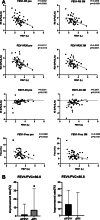Real-life effectiveness of dupilumab in patients with mild to moderate bronchial asthma comorbid with CRSwNP
- PMID: 35764984
- PMCID: PMC9241284
- DOI: 10.1186/s12890-022-02046-3
Real-life effectiveness of dupilumab in patients with mild to moderate bronchial asthma comorbid with CRSwNP
Abstract
Background: Dupilumab, an anti-IL-4α receptor antibody, is a new treatment for severe or refractory asthma. However, real-world evidence on the efficacy of dupilumab in patients with mild to moderate bronchial asthma is lacking.
Methods: We retrospectively evaluated the effects of dupilumab in 62 patients who received dupilumab for eosinophilic sinusitis comorbid with asthma at a single centre in Japan. Type 2 inflammatory markers, ACT, respiratory function tests, and forced oscillation technique (FOT) were analysed before, three months after, and one year after dupilumab administration, mainly in patients with mild to moderate asthma.
Results: FEV1, %FEV1, %FVC, treatment steps for asthma and ACT improved significantly after three months of dupilumab treatment. FeNO was markedly decreased, whereas IgE and eosinophil counts showed no significant changes. Pre- and post-treatment respiratory resistance (Rrs) and respiratory reactance (Xrs) correlated significantly with FEV1. Improvement in %FEV1 was associated with higher FeNO and higher serum IgE before dupilumab treatment.
Conclusion: Dupilumab treatment for sinusitis may improve respiratory functions, asthma symptoms, and asthma treatment reduction, even if the associated bronchial asthma is not severe.
Keywords: Bronchial asthma; Chronic sinusitis; Dupilumab; Forced oscillation technique; Nasal polyps.
© 2022. The Author(s).
Conflict of interest statement
The authors declare that there are no financial or non-financial types of interest related to the submitted article.
Figures




Similar articles
-
Comorbid asthma in patients with chronic rhinosinusitis with nasal polyps: did dupilumab make a difference?BMC Pulm Med. 2023 Jul 18;23(1):266. doi: 10.1186/s12890-023-02556-8. BMC Pulm Med. 2023. PMID: 37464395 Free PMC article.
-
Real-life effects of dupilumab in patients with severe type 2 asthma, according to atopic trait and presence of chronic rhinosinusitis with nasal polyps.Front Immunol. 2023 Mar 30;14:1121237. doi: 10.3389/fimmu.2023.1121237. eCollection 2023. Front Immunol. 2023. PMID: 37063895 Free PMC article.
-
Eosinophil Cationic Protein Variation in Patients with Asthma and CRSwNP Treated with Dupilumab.Life (Basel). 2023 Sep 8;13(9):1884. doi: 10.3390/life13091884. Life (Basel). 2023. PMID: 37763288 Free PMC article.
-
Dupilumab: A Review in Chronic Rhinosinusitis with Nasal Polyps.Drugs. 2020 May;80(7):711-717. doi: 10.1007/s40265-020-01298-9. Drugs. 2020. PMID: 32240527 Review.
-
Dupilumab-induced hypereosinophilia: review of the literature and algorithm proposal for clinical management.Expert Rev Respir Med. 2022 Jul;16(7):713-721. doi: 10.1080/17476348.2022.2090342. Epub 2022 Jun 23. Expert Rev Respir Med. 2022. PMID: 35703018 Review.
Cited by
-
Efficacy and safety of dupilumab in the treatment of CRSwNP in the real-life setting: a review of the literature.Eur Arch Otorhinolaryngol. 2024 Oct;281(10):5023-5031. doi: 10.1007/s00405-024-08725-7. Epub 2024 May 19. Eur Arch Otorhinolaryngol. 2024. PMID: 38762844 Review.
-
Efficacy and limitations of systemic corticosteroids in patients with CRSwNP compared to alternative therapies with monoclonal antibodies: real-life of 101 patients from the Lazio region, Italy.Front Allergy. 2025 Jun 16;6:1573764. doi: 10.3389/falgy.2025.1573764. eCollection 2025. Front Allergy. 2025. PMID: 40589491 Free PMC article.
-
Real-world evidence for the effectiveness and safety of dupilumab in patients with CRSwNP after 1 year of therapy.World Allergy Organ J. 2023 May 18;16(5):100780. doi: 10.1016/j.waojou.2023.100780. eCollection 2023 May. World Allergy Organ J. 2023. PMID: 37234094 Free PMC article.
-
Effect of Dupilumab in CRSwNP Sinonasal Outcomes from Real Life Studies: A Systematic Review with Meta-analysis.Curr Allergy Asthma Rep. 2025 Feb 5;25(1):13. doi: 10.1007/s11882-025-01192-y. Curr Allergy Asthma Rep. 2025. PMID: 39907855 Free PMC article.
-
Effectiveness of dupilumab treatment against refractory eosinophilic chronic rhinosinusitis.J Allergy Clin Immunol Glob. 2025 Jan 16;4(2):100412. doi: 10.1016/j.jacig.2025.100412. eCollection 2025 May. J Allergy Clin Immunol Glob. 2025. PMID: 40008098 Free PMC article.
References
MeSH terms
Substances
LinkOut - more resources
Full Text Sources
Medical

